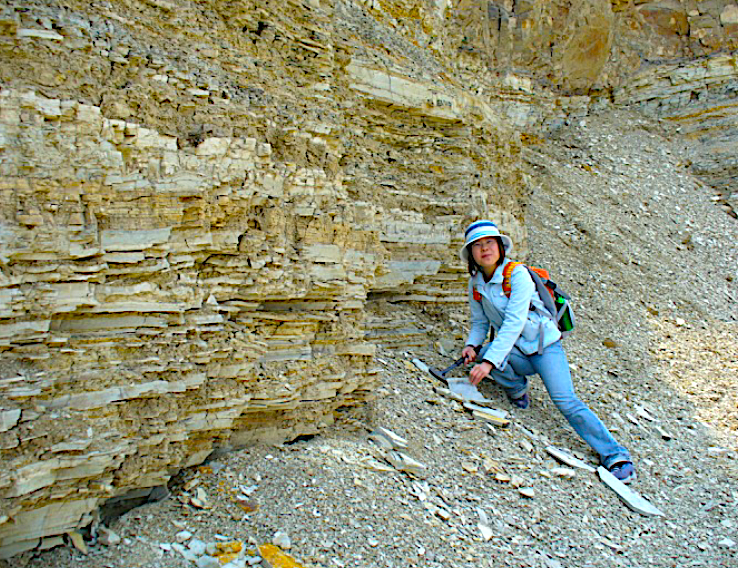Yixian Fm
Type Locality and Naming
W. Liaoning. W. Muroi erected the Yixian volcanic rocks in 1940. The section for the designation is near Yixian of west Liaoning. The reference section is from Mashenmiao-Songbahu of the Yixian County, Liaoning.
Lithology and Thickness
The Yixian Formation is mainly represented by a set of volcanic-pyroclastic rock series. The Lower and Middle parts of the formation are mainly built up by yellow gray and gray black basalt, with basaltic breccia lava and sedimentary rocks, while the Upper part is dominated by andesite and andesitic volcanic breccia with clastic sedimentary rocks. It is 2442.20 m thick.
[Figure: Sihetun section of Yixian Formation in Yixian of Liaoning Province]
[Figure: Yixian Formation in Sichakou of Fengning, Liaoning Province]
Relationships and Distribution
Lower contact
The unconformable base of the formation marked by yellow gray tuffaceous sandy conglomerate is distinguished from the Gaoyuzhuang Fm of the Changcheng series marked by gray black medium and thick-bedded dolomitic limestone with chert bands. Regionally, the next older unit is usually a discontinuity above the Tuchengzi Fm of late Jurasic-early Cretaceous.
Upper contact
The disconformable top is bounded by the appearance of gray green sandy shale at the base of the Jiufotang Fm.
Regional extent
The present formation is widespread in the Yanliao region and varies considerably both in lithology and thickness. In the Yixian-Jinzhou area, it is dominated by rhyolite and rhyolitic pyroclastic rocks with small amounts of andesite, measuring more than 1670 m in thickness. In the Fuxin-Qinghemen area, it is represented by a set of andesite with multiple layers of sedimentary rocks, volcanic breccia and tuff with 6-8 sedimentary rock beds, measuring 1238 m in thickness. In the Gujialing-Shanghuxiangou area, it is built up by basalt, andesite, latite and volcanic breccia with multiple layers of sedimentary rocks, with a thickness of 4000 m. In the Lamadong area, it increases in the number of sedimentary partings, with a single parting of up to 782 m thick and with a total thickness of 3275 m. In the Daxinfangzi area of Lingyuan, the sedimentary partings are more than 1000 m thick. The Yixian Formation is 713-4000 m thick in west Liaoning, 33-42576 m in Tieling-Faku, 2415.5-2796.5 m in the Xifeng area, 1303 m in the Xunhe area, 916.4-3026.5 m in east Liaoning, 452-278 m in south Liaoning, and 177.1 m in north Hebei. It is called the Deren Fm, the Jiuda Fm and the Anmin Fm in the Xifeng area, the Nankangzhuang Fm and the Gushan Fm in the Xunhe area, the Xiaoling Fm and the Lishugou Fm in east Liaoning, the Guiyunhua Fm in south Liaoning, and the Dabeigou Fm in north Hebei (5-13 beds). In Liaoning and north Hebei, the Yixian Formation lies conformably or unconformably on the Pre-Paleozoic or the Jurassic, and conformably or disconformably under the Jiufotang Fm. In the Lingyuan area, it possesses bentonite and zeolite; in Lingyuan, Shahai and Xinlitun; and perlite in Jianping and Lingyuan.
GeoJSON
Fossils
It yields charophytes, plant mega- and microfossils including angiosperms, conchostracans including Eosestheria spp., ostracods, shrimps, insects, brackish-water gastropods such as Probaicalia gerassimovi and P. vitimensis, bivalves such as Arguniella cf. quadrata, A. cf. ventricosa and Sphaerium (Sphaerium) anderssoni =S. jeholense], fish, amphibians, reptiles including feathered dinosaurs, birds and mammals. The formation mainly yields estherias Eosestheria sinensis, E. jeholinsis, Diestheria yixianensis; insects Ephemeropsis trisetulis; Reptilia Manchurochelys manchouensis; in Liujiawopu of Lingyuan, the lower member of the formation yields ostracods Cypridea venustata, Lycopterocypris circulata; in Sanguanmiao of Kazuo, ostracods Cypridea ganzhaoensis, Ziziphocypris linchengensis; in Jianshangou of Miaomidianzi of Beipiao, the Cicatricosisporites-Densoisporites-Jugella assemblage; in Jingangshan of the Zaocishan area ostracods Cypridea veridica, Darwinula contracta and the Cicatricosisporites-Foraminisporis assemblage. It also yields abundant Fish of multiple taxa Lycopter davidi, Lycoptera muroii, Peipiaosteus pani; estheria Eosestheria spp.; bivalves Nakamuranaia spp.; insects Ephimeropsis trisetalis; ostracods Cypridea tumescens, C. dunkeri, C. granulsa, etc. The flora assemblage of the Yixian Formation contains index fossil plants of the Barremian-Aptian Late Turga flora assemblage of the Transbaikalia.
Age
Depositional setting
The Yixian Formation belongs to volcanic intermittent lacustrine deposition.
Additional Information
Enhanced with Igor N. Kosenko, Jingeng Sha and Boris N. Shurygin (2021). Upper Mesozoic stratigraphy of Sikhote-Alin (Russian Far East) and northeastern China: Non-marine and marine correlations. Part 1: Upper Jurassic-Hauterivian AND 2. Barremian-Aptian. Cretaceous Research, 124: articles 104811 (https://doi.org/10.1016/j.cretres.2021.104811) AND 104812 (https://doi.org/10.1016/j.cretres.2021.104812)

